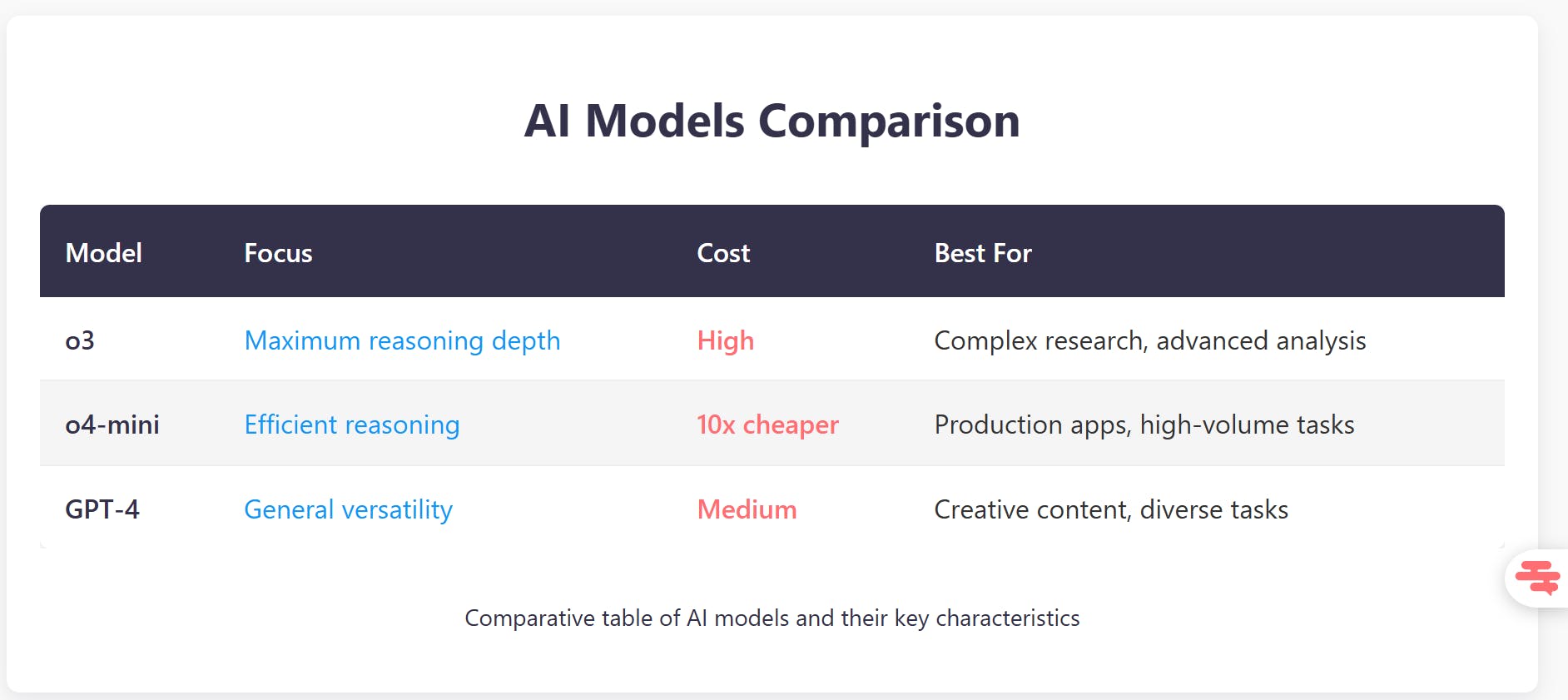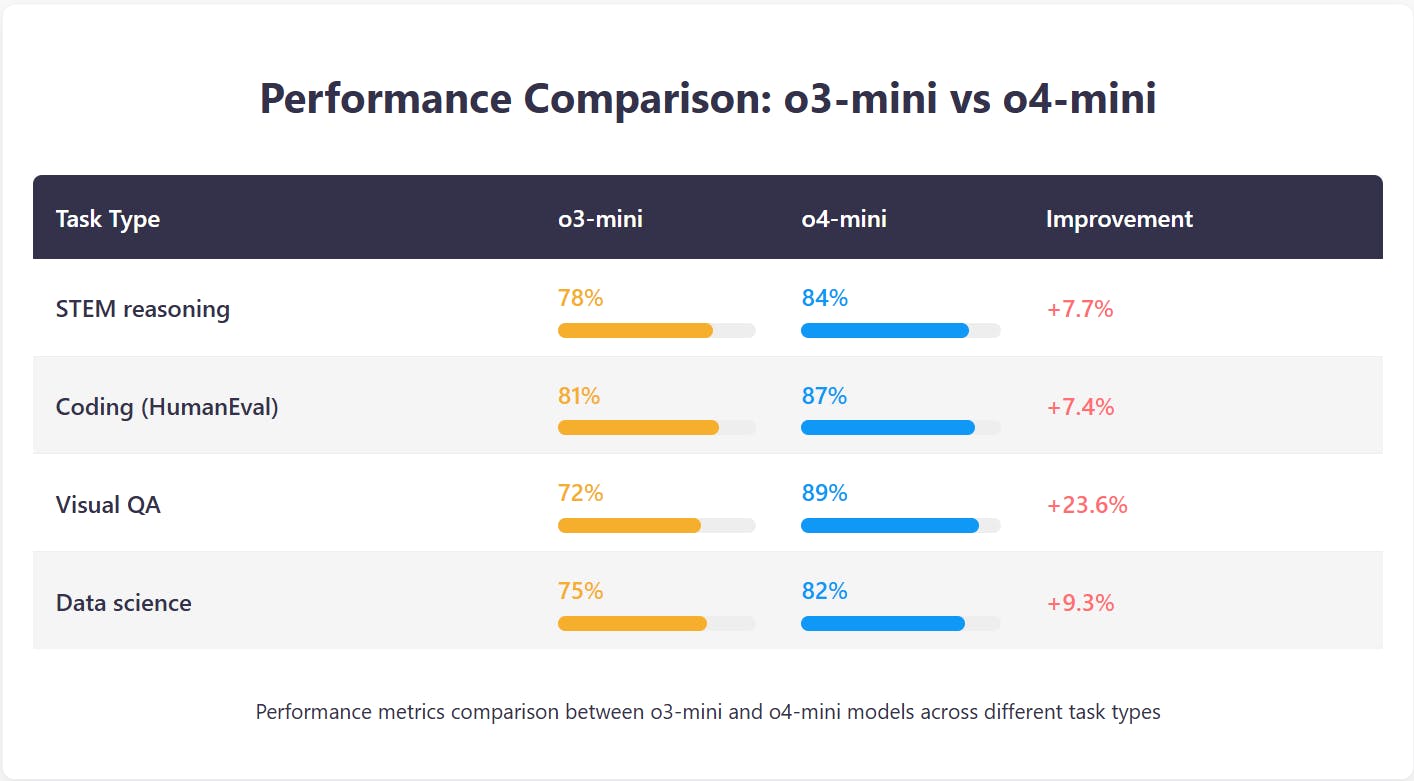Table of contents :
O4-Mini OpenAI Model: Complete technical guide and official specifications
The o4-mini OpenAI model represents a strategic shift in AI accessibility. Officially announced on April 16, 2025, this compact reasoning model delivers 20% better performance than o3-mini while reducing costs by 10x. But what exactly makes the OpenAI o4-mini model stand out, and how do its capabilities translate into real-world applications? This comprehensive guide covers everything from official o4-mini OpenAI model details to performance benchmarks, helping you determine if this model fits your technical requirements.
What is the OpenAI o4-mini Model?
Official OpenAI o4-mini model announcement
The o4-mini OpenAI model was unveiled on April 16, 2025, as part of OpenAI's "o-series" focused on advanced reasoning capabilities. Unlike GPT models optimized for general text generation, the o4-mini model OpenAI prioritizes:
- Structured reasoning through chain-of-thought architecture
- Multimodal processing (text + images natively integrated)
- Cost efficiency with 10x lower pricing than o3
- Universal accessibility for free-tier ChatGPT users
Key technical specifications:
- Context window: 200,000 tokens
- Output capacity: Up to 100,000 tokens
- Knowledge cutoff: June 1, 2024
- Native multimodal support: Yes
- API availability: Chat Completions & Responses APIs
What is o4-mini OpenAI? Positioning in the ecosystem
The o4 mini OpenAI model bridges the gap between premium reasoning models (o3) and accessible AI tools:

This positioning makes o4-mini OpenAI the optimal choice for developers needing reasoning capabilities at scale.
OpenAI o4-mini model description: Core architecture
Chain-of-Thought processing
The OpenAI o4-mini model description centers on its revolutionary architecture:
1. Sequential reasoning steps
- Breaks complex problems into logical stages
- Transparent thought process (users can track each step)
- 35% reduction in reasoning errors vs. previous models
2. Deliberative alignment
- Analyzes ethical implications of requests
- Reduces false positives in content filtering
- Balances safety with usability
3. Multimodal integration
Unlike previous models treating images as separate inputs, o4-mini OpenAI processes visual information within its reasoning chain.
Result: The model interprets visual elements as part of its reasoning process, not as isolated data points.
o4-mini-high OpenAI model: Premium variant explained
OpenAI o4-mini model details: Standard vs. High
The o4-mini-high OpenAI model offers enhanced analytical depth for complex tasks:

When to Choose o4-mini-high:
- Multi-layered problem-solving (e.g., legal document analysis)
- Long-context reasoning (analyzing 50+ page reports)
- Tasks requiring nuanced interpretation
When standard o4-mini suffices:
- Code generation and debugging
- Data extraction from documents
- Mathematical problem-solving
- Real-time applications
OpenAI o4-mini model capabilities: Technical breakdown
Official OpenAI o4-mini model capabilities
1. Mathematical reasoning
- AIME 2024 benchmark: Best-performing model in its class
- Solves competition-level math problems
- Shows step-by-step solution paths
Example use case:
Input: "Solve: If 3x + 7 = 25 and 2y - x = 5, find x and y"
Output: To solve the system
[ \begin{cases} 3x + 7 = 25,\ 2y - x = 5, \end{cases} ]
- From (3x + 7 = 25):
3x = 25 - 7 = 18)
(\displaystyle x = \frac{18}{3} = 6.)
- Substitute (x=6) into (2y - x = 5):
(2y - 6 = 5)
(2y = 11)
(\displaystyle y = \frac{11}{2}.)
Answer:
[ x = 6,\quad y = \frac{11}{2}. ]
2. Advanced coding
- Generates production-ready code with explanations
- Debugs complex logic errors
- Supports Python, web browsing integration, function calling
3. Visual analysis
The OpenAI o4-mini model what is it most known for? Its native visual reasoning:
- Sketch interpretation: Analyzes hand-drawn diagrams
- Chart analysis: Extracts trends from graphs
- Handwriting recognition: Processes handwritten formulas
- Whiteboard comprehension: Understands brainstorming sessions
Real-world application:
A healthcare provider uses o4-mini to analyze medical records combining text reports and diagnostic images, reducing analysis time by 60%.
4. Structured outputs
Supports JSON mode for reliable data extraction.
Official benchmarks and performance metrics
OpenAI o4-mini model official performance
Comparative benchmarks:

Energy efficiency:
- 40% reduced consumption vs. o3-mini
- 25% faster response times
- 30% lower token usage for equivalent tasks
Reliability metrics:
- Hallucination rate: 35% lower than GPT-4
- Reasoning error rate: 2.3% (vs. 3.8% for o3-mini)
- Context retention: 98.7% accuracy across 200K token window
Practical implementation guide
Getting started with o4-mini OpenAI
- API Integration
- Multimodal Workflow
- Function Calling for Automation
Industry-specific applications
Healthcare:
- Medical record analysis (text + imaging)
- Diagnostic assistance with reasoning transparency
- Regulatory compliance documentation
Finance:
- Real-time risk assessment
- Regulatory compliance verification
- Automated document analysis with audit trails
Utilities & Public services:
- Energy demand forecasting
- Infrastructure data analysis
- Predictive maintenance scheduling
Education:
- Personalized tutoring with step-by-step explanations
- Automated grading with detailed feedback
- Research assistance for students
How to Access o4-mini with Swiftask
Swiftask offers seamless o4-mini OpenAI integration with additional advantages:
1. Multi-Model Orchestration : Instead of using o4-mini in isolation, create intelligent workflows:
- Step 1: o4-mini analyzes raw data
- Step 2: GPT-4 generates creative content
- Step 3: Claude refines tone and style
- Step 4: Automated publishing
Expert Accompaniment
- Half-day onboarding session
- Custom agent creation for your specific use case
- Immediate ROI with operational agents
Enterprise integration
- Native Azure AD SSO
- Role-based access control (RBAC)
- Centralized monitoring dashboard
- Compliance-ready architecture
Example Workflow:
Document Upload → o4-mini extracts key data → GPT-4o writes executive summary → Mistral translates to 5 languages → Automated distribution
author
OSNI

Published
April 28, 2025